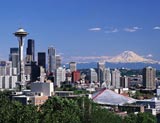 Ever wondered whether caffeine is a viable1 substitute for sunshine? If so, Seattle is your kind of town. More than any other city in the region, Seattle epitomizes(浓缩) what people know of the Pacific Northwest. Nevermind that its sunshiny days can be suicidally few - its residents are among the nation's most outgoing and outdoorsy(爱好野外活动的). Sure, it had everybody wearing flannel2 (法兰绒)shirts and whistling Nirvana for a while, but consider also the good things it's given us: the city's chilly3 mornings had the espresso(浓咖啡) generation brewing4 long before Starbucks sold its first cup. If you're looking for lifestyle, Seattle has it in spades(肯定地). Ever wondered whether caffeine is a viable1 substitute for sunshine? If so, Seattle is your kind of town. More than any other city in the region, Seattle epitomizes(浓缩) what people know of the Pacific Northwest. Nevermind that its sunshiny days can be suicidally few - its residents are among the nation's most outgoing and outdoorsy(爱好野外活动的). Sure, it had everybody wearing flannel2 (法兰绒)shirts and whistling Nirvana for a while, but consider also the good things it's given us: the city's chilly3 mornings had the espresso(浓咖啡) generation brewing4 long before Starbucks sold its first cup. If you're looking for lifestyle, Seattle has it in spades(肯定地).
Seattle is situated5 in the west of Washington, the northwesternmost state. The largest city in the state, Seattle sits on a skinny slip of land between the Puget Sound(普吉特海湾) and Lake Washington. Lake Union and the Lake Washington Ship Canal divide the city into northern and southern halves; downtown and the Capitol Hill and Queen Anne neighborhoods lie south of the canal, the U District is to the northeast.
Compared to the rest of the city, downtown orientation6 is pretty straightforward7. Historic Pioneer Square contains most of the must-see sites. Seattle Center, home to many of the city's cultural and sport facilities, is just northwest of downtown.
 Before the arrival of Europeans, the Seattle area was home to the Duwamish, a generally peaceable tribe that fished the bays and rivers of the Puget Sound and befriended(帮助) early white settlers. In 1851, a native New Yorker named David Denny led the first group of settlers across the Oregon Trail with the intention of settling along the Puget Sound. Recognizing the area's seaport8 possibilities, Denny's band staked a claim on Alki Point in present-day West Seattle. After a winter of wind and rain, the group moved the settlement to Elliott Bay (依利雅特湾), renaming it Seattle for the Duwamish chief Sealth, a friend of an early merchant. Before the arrival of Europeans, the Seattle area was home to the Duwamish, a generally peaceable tribe that fished the bays and rivers of the Puget Sound and befriended(帮助) early white settlers. In 1851, a native New Yorker named David Denny led the first group of settlers across the Oregon Trail with the intention of settling along the Puget Sound. Recognizing the area's seaport8 possibilities, Denny's band staked a claim on Alki Point in present-day West Seattle. After a winter of wind and rain, the group moved the settlement to Elliott Bay (依利雅特湾), renaming it Seattle for the Duwamish chief Sealth, a friend of an early merchant.
Hardly a boomtown(新兴城市), early Seattle was peopled mainly by bachelors until one of the founding fathers went back east on a mission to induce young unmarried women to come to Seattle. On two different trips, a total of 57 women made the journey and married into the frontier stock, in the process setting a more civilized9 tone for the city. A spur(铁路的支线) from the Northern Pacific Railroad's terminus in Portland reached Seattle in 1893, linking the town by rail with the rest of the country. The lumber10, shipping11 and general commerce derived12 from immigration soon swelled13 the town's ranks so much that even the Great Fire of 1889 barely slowed the advance. After 50 blocks of the old wooden downtown burned in a single day, the city was reborn in brick and iron, centered on today's Pioneer Square.
Seattle's first boom came when the ship Portland docked in 1897 with its now-famous cargo14: two tons of Yukon gold. Within weeks, thousands of fortune hunters from across the country passed through on their way to the northern gold fields. Local business blossomed as Seattle became the banking15 center for the nouveau riche(爆发户), and the bars, brothels(妓院) and honky-tonks(下等酒馆) of Pioneer Square overflowed16 with pleasure-starved miners.
The boom continued through WWI, when Northwest lumber was greatly in demand and shipyards along the Puget Sound 'harvested' the surrounding forests. WWII furthered the shipbuilding boom, and aircraft and atomic energy industries added to the region's pattern of profit. Today, international trade and tech firms (such as Microsoft and Amazon) make up the backbone17(支柱) of Seattle's booming economy. And although Boeing, for decades as synonymous with Seattle as rain, announced in 2001 that it was up and leaving for windier pastures in Chicago, the city's progressive politics, inventive culture and ready access to outdoor recreation continue to lure18 restless people like no place else on the West Coast.
|
 收听单词发音
收听单词发音 
